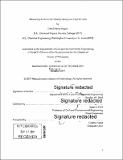| dc.contributor.author | Hagan, David Henry. | en_US |
| dc.contributor.other | Massachusetts Institute of Technology. Department of Civil and Environmental Engineering. | en_US |
| dc.date.accessioned | 2021-12-17T17:08:57Z | |
| dc.date.available | 2021-12-17T17:08:57Z | |
| dc.date.copyright | 2019 | en_US |
| dc.date.issued | 2020 | en_US |
| dc.identifier.uri | https://hdl.handle.net/1721.1/138522 | |
| dc.description | Thesis: Ph. D., Massachusetts Institute of Technology, Department of Civil and Environmental Engineering, February, 2020 | en_US |
| dc.description | "February 2019." Author's name in February 2020 and not in February 2019 MIT Registry degree list. Manuscript. "The images contained in this document are of the best quality available"--Disclaimer page. | en_US |
| dc.description | Includes bibliographical references (pages 130-146). | en_US |
| dc.description.abstract | Exposure to ambient air pollution increases morbidity and mortality - it is the leading environmental risk factor for the global burden of disease. Accurate and reliable air quality measurements can help identify sources of pollution, enabling mitigation strategies that lead to longer, healthier lives and reduce the economic impact caused by air pollution. Low-cost sensors (LCS) offer the opportunity to vastly increase our ability to make air quality measurements with finer spatiotemporal resolution than ever before; however, the use of such sensors has outpaced our understanding of their abilities, limitations, and overall utility. This thesis describes several detailed characterization experiments and modeling exercises that were carried out to better understand the strengths and limitations of using LCS for measuring air pollution and investigates new ways in which they can be used to identify types and sources of particulate pollution. First, we explore the use of electrochemical sensors for measuring sulfur dioxide in Hawaii. We introduce a new algorithm for reducing the uncertainty while still capturing high concentration data points and we demonstrate that electrochemical sensor performance does not degrade over the course of several months. Second, we investigate the long-term viability of electrochemical sensors with a three-year deployment in Boston. We show that CO and NO electrochemical sensors show little-to-no degradation over the course of at least two years. Third, we designed and built a Mie Theory-based model for exploring the ability of low-cost particle sensors to accurately measure fine particles. We show the expected differences between two commonly used technologies under a variety of ambient conditions. Last, we demonstrate how multipollutant LCS, despite their inherent limitations, can be used to provide insight into sources of fine particulate matter in complex urban environments. The results from this work demonstrate that LCS can be viable tools that can be integrated into the greater air quality measurement ecosystem and can be used to obtain reliable data at scales previously unseen. | en_US |
| dc.description.statementofresponsibility | by David Henry Hagan. | en_US |
| dc.format.extent | 146 pages | en_US |
| dc.language.iso | eng | en_US |
| dc.publisher | Massachusetts Institute of Technology | en_US |
| dc.rights | MIT theses may be protected by copyright. Please reuse MIT thesis content according to the MIT Libraries Permissions Policy, which is available through the URL provided. | en_US |
| dc.rights.uri | http://dspace.mit.edu/handle/1721.1/7582 | en_US |
| dc.subject | Civil and Environmental Engineering. | en_US |
| dc.title | Measuring ambient air quality using low-cost sensors | en_US |
| dc.type | Thesis | en_US |
| dc.description.degree | Ph. D. | en_US |
| dc.contributor.department | Massachusetts Institute of Technology. Department of Civil and Environmental Engineering | en_US |
| dc.identifier.oclc | 1281671720 | en_US |
| dc.description.collection | Ph. D. Massachusetts Institute of Technology, Department of Civil and Environmental Engineering | en_US |
| dspace.imported | 2021-12-17T17:08:57Z | en_US |
| mit.thesis.degree | Doctoral | en_US |
| mit.thesis.department | CivEng | en_US |
